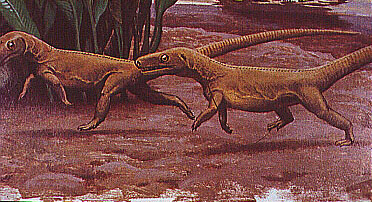Introduction to Euparkeria

Euparkeria is a close relative of the archosaurs, and is known only from a single locality in the Lower Triassic of southern Africa. Most grew to about half a meter in length.
The body form of Euparkeria is unusual in that the relative length of its hind limbs to its forelimbs exceeds that of other comparable reptiles of its time. Some have suggested that Euparkeria may have been "facultatively bipedal" (Carroll 1988), and able to run on two legs for short distances as pictured above.
The systematic position of Euparkeria is problematic. The question of its relationships hinges upon the structure of the ankle joint, a pivotal character in understanding the evolution of archosaurs. Whatever the actual case was, there is general agreement that it is either the sister group to all other Archosauria, or is part of the lineage leading to the dinosaurs.
Sources:
- Carroll, R.L. 1988. Vertebrate Paleontology and Evolution. W.H. Freeman, NY.
- Cruickshank, A.R.I., and M.J. Benton. 1985. Archosaur ankles and relationships of the thecodontian and dinosaurian reptiles. Nature 317:715-717.
- Gauthier, J.A. 1986. Saurischian monophyly and the origin of birds. In K. Padian (ed). The Origin of Birds and the Evolution of Flight. Memoirs of the California Academy of Sciences 8:1-55.